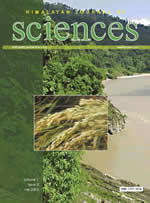<i>Quercus semecarpifolia</i> Sm. in the Himalayan region: Ecology, exploitation and threats
DOI:
https://doi.org/10.3126/hjs.v1i2.212Keywords:
Himalayan region, oak, Q. semecarpifolia, khasru, regeneration of QuercusAbstract
Oaks (Quercus spp.) are among the dominant vascular plants of the Himalayas, ranging from the subtropical to the sub-alpine zones. They play an important role in maintaining ecosystem stability. Oaks in the Himalayan region are intimately linked with subsistence hill agriculture as they protect soil fertility, watershed and local biodiversity. They also supply fodder, leaf litter, firewood and timber. Q. semecarpifolia is a high altitude oak, ranging up to the timberline in the Himalayan region and forming the climax community on the southern aspect; it is considered to be one of the oldest plants of the region. It is also one of the most over-exploited species and fails to regenerate adequately either in disturbed or undisturbed natural habitat. Since plantation has not been successful, it is important to manage natural forest more effectively. This can be done by implementing sustainable methods of lopping the trees for fodder, removing an adequate number of old and dying trees to make the canopy more open, and controlling the population of cattle and wild animals that damage seedlings through browsing and trampling. Key words: Himalayan region, oak, Q. semecarpifolia, khasru, regeneration of Quercus Himalayan Journal of Sciences 1(2): 126-128, 2003Downloads
Download data is not yet available.
Abstract
2017
PDF
2093
Downloads
How to Cite
Shrestha, B. B. (2006). <i>Quercus semecarpifolia</i> Sm. in the Himalayan region: Ecology, exploitation and threats. Himalayan Journal of Sciences, 1(2), 126–128. https://doi.org/10.3126/hjs.v1i2.212
Issue
Section
Articles




